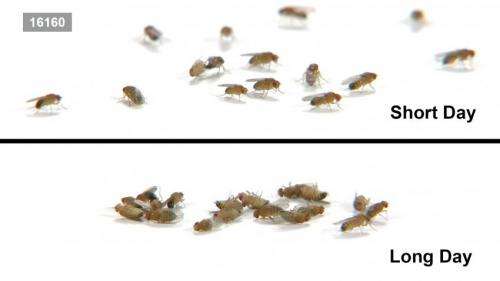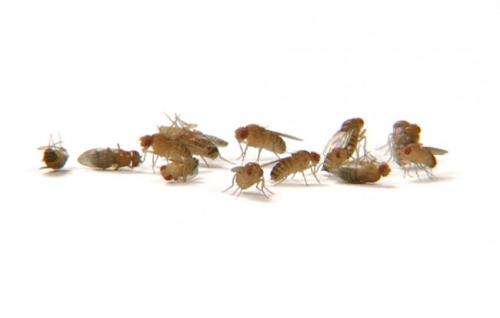Breakthrough study identifies genetic link between the circadian clock and seasonal timing

Researchers from the University of Leicester have for the first time provided experimental evidence for a genetic link between two major timing mechanisms, the circadian clock and the seasonal timer.
New research from the Tauber laboratory at the University of Leicester, which will be published in the academic journal PLOS Genetics on 4 September, has corroborated previous observations that flies developed under short days become significantly more cold-resistant compared with flies raised in long-days, suggesting that this response can be used to study seasonal photoperiodic timing.
Photoperiodism is the physiological reaction of organisms to the length of day or night, occurring in both plants and animals.
Dr Mirko Pegoraro, a member of the team, explained: "The ability to tell the difference between a long and short day is essential for accurate seasonal timing, as the photoperiod changes regularly and predictably along the year."
The difference in cold response can be easily seen using the chill-coma recovery assay - in which flies exposed to freezing temperatures enter a reversible narcosis. The recovery time from this narcosis reflects how cold-adaptive the flies are.
The team has demonstrated that this response is largely regulated by the photoperiod - for example, flies exposed to short days (winter-like) during development exhibit shorter recovery times (more cold adapted) during the narcosis test.
Dr Eran Tauber from the University of Leicester's Department of Genetics explained: "Seasonal timing is a key process for survival for most organisms, especially in regions with a mild climate. In a broad range of species, from plants to mammals, the annual change in day-length is monitored by the so-called 'photoperiodic clock'.

"Many insects for example, including numerous agricultural pests, detect the shortening of the day during the autumn and switch to diapause - a developmental arrest - which allows them to survive the winter.
"Despite intensive study of the photoperiodic clock for the last 80 years, however, the underlying molecular mechanism is still largely unknown. This is in marked contrast to our understanding of the circadian clock that regulates daily rhythms."
The team has tested mutant strains in which the circadian clock is disrupted and has found that the photoperiodic clock was also disrupted, providing the first experimental evidence for the role of the circadian clock in seasonal photoperiodic timing in flies.
The new research is based on an automated system, allowing the monitoring of hundreds of flies, which paves the way for new insights into our understanding of the genes involved in the photoperiodic response and seasonal timing.
Professor Melanie Welham, Executive Director for Science, at the Biotechnology and Biological Sciences Research Council (BBSRC), said: "This study shows an interesting genetic link between the circadian clock and the seasonal timer. The ubiquity of these clocks across so many species makes this an important discovery which will lead to a better understanding of these essential processes."
More information: The study will be published in PLOS Genetics from 4 September 2014: www.plosgenetics.org/doi/pgen.1004603
Journal information: PLoS Genetics
Provided by University of Leicester


















